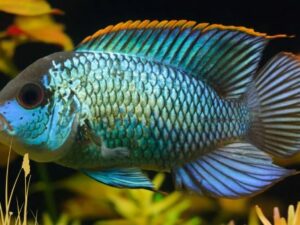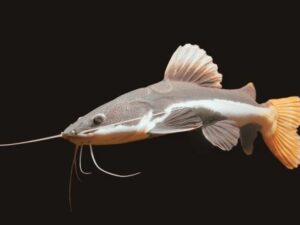Harlequin Rasbora (Trigonostigma heteromorpha) is a beautiful freshwater fish from Southeast Asia. It is a member of the cyprinid family and typically grows to be about 2.5 inches (6.4 cm) in length. This is a schooling fish, so it should be kept in groups of at least six.
The Harlequin Rasbora is a peaceful community fish that does well in a planted aquarium with other small, delicate fish. The Harlequin Rasbora is a hardy fish that is easy to care for, making it a good choice for beginner aquarists.
In this article, we will discuss the care and keeping of the Harlequin Rasbora, including how to set up a tank for them, what to feed them, and how to keep them healthy. You will get a complete guide about the harlequin rasbora by reading this article. We will look at their behavior, breeding their appearance breeding, and their social structure.
Table of Contents
Harlequin Rasbora: Species Summary
| Common Name: | Harlequin Rasbora, Blue Harlequin, green Harlequin |
| Scientific Name: | Trigonostigma Heteromorpha |
| Family: | Cichlidae |
| Origin: | Southeast Asia |
| Size: | 2.5 inches (6.4 cm) |
| Lifespan: | 5 to 8 years |
| Temperature range: | 72 to 79 Degrees Fahrenheit |
| pH range: | 6.0 to 7.5 |
| Minimum Tank size: | 20 gallons |
| Care Level: | Easy |
| Diet: | Omnivorous |
Harlequin Rasbora: Appearance and Characteristics
The Harlequin Rasbora is a small, slender fish with a torpedo-shaped body. This fish adds beautiful color to your freshwater tank. The greenish-blue body has a large, black triangle-shaped patch on the caudal peduncle (between the dorsal and anal fins).
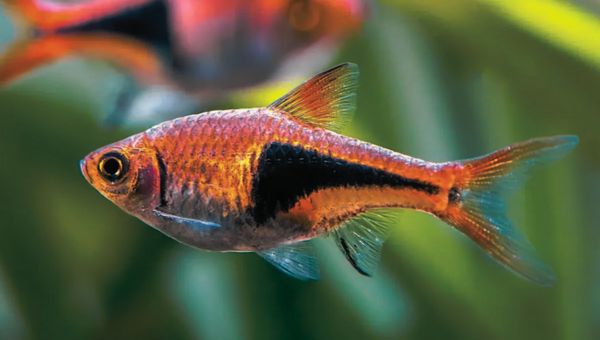
The fins are transparent with no coloration. Males and females look similar, but males are usually larger and have more vivid coloration. The eyes are orange-red and look very beautiful.
Harlequin Rasbora: Origin and Distribution
The Harlequin Rasbora is a freshwater fish that originates from Southeast Asia. It is found in Thailand, Malaysia, Indonesia, and Singapore.
Harlequin Rasbora: Lifespan
The Harlequin Rasbora typically grows about 2.5 inches (6.4 cm) in length. This fish has a lifespan of 5 to 8 years. They will increase for the first year and then reach their adult size.
Harlequin Rasbora: Food and Diet
The Harlequin Rasbora will eat most types of food. The Harlequin Rasbora is an omnivore that feeds on various wild items, including insects, zooplankton, and plant matter.
Diet and Nutrition in Captivity
In captivity, the Harlequin Rasbora should be fed various foods, including live, frozen, and flake. Live foods like brine shrimp, bloodworms, and daphnia are excellent choices. Frozen foods such as mosquito larvae and krill are also good options. Flake food or pellets should be a small part of their diet, as they are not nutritionally complete.
Feeding Frequency
The Harlequin Rasbora should be fed 2 to 3 times a day. They should only be given as much food as possible in 2 minutes. Giving them more food will result in uneaten food decomposing and causing pollution in the aquarium.
Feeding Methods
The best way to feed the Harlequin Rasbora is to use a feeding ring or tube. This will keep the food in one place and make it easier for the fish to eat. Other ways can be used, but the food may end up in the aquarium filter or on the bottom of the tank.
Using a Feeding Ring
- Place the feeding ring in the aquarium.
- Add the food to the ring.
- The fish will eat the food from the ring.
- Remove the ring after 2 minutes or when all the food is gone.
- Repeat 2 to 3 times a day.
Using a Feeding Tube
- Place the tube in the aquarium.
- Add the food to the tube.
- The fish will eat the food from the tube.
- Remove the tube after 2 minutes or when all the food is gone.
- Repeat 2 to 3 times a day.
Harlequin Rasbora: Behavior and Temperament
The Harlequin Rasbora is a peaceful community fish that does well in a tank with other small, delicate fish. These are schooling fish and should be kept in groups of at least six. They are timid and will hide if they feel threatened. The Harlequin Rasbora is a peaceful fish that is not known to nip at the fins of other fish. Their behavior towards humans is unknown.
Harlequin Rasbora Care Guide
The Harlequin Rasbora is a straightforward fish to care for. They are very hardy and can withstand a wide range of water conditions. They are also very good at hiding, so they are not easily bullied by other fish. They are peaceful fish and can be kept with various tank mates. They are best kept in groups of 6 or more. If they are kept alone, they might get stressed.
The Harlequin Rasbora is a very active fish and will swim around the entire tank. They are also good jumpers, so a tight-fitting lid is necessary to prevent them from jumping out of the tank.
Harlequin Rasbora: Tank Size
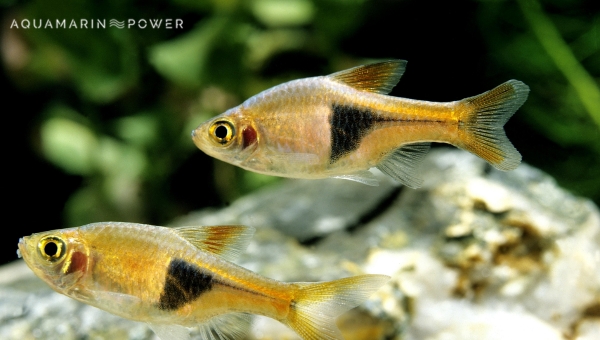
The Harlequin Rasbora requires a tank size of at least 20 gallons. They need a 20-gallon tank or langer than that because they are schooling fish. The minimum dimension must be 12 inches (30 cm). Larger tanks will provide more swimming space and allow for more hiding places.
Water Quality
The Harlequin Rasbora prefers a pH range of 6.0 to 7.5 and a water temperature range of 72 to 79 degrees Fahrenheit (20 to 26 degrees Celsius).
They can tolerate a water hardness up to 20 dGH. The water should be well-oxygenated and have a low to moderate carbon dioxide (CO2) level. The salinity of the water must be very low, less than 0.5 parts per million (ppm). The gravity must be between 1.002 and 1.008.
Water Changes
Keeping the water clean is very necessary. The Harlequin Rasbora is a sensitive fish and can be easily stressed by poor water quality. A 20% water change should be done every two weeks. The filter should be cleaned every month.
Water Conditioner
A water conditioner is a necessary part of keeping the Harlequin Rasbora healthy. This fish is sensitive to chemicals such as chlorine and chloramine, which are found in tap water. A water conditioner will remove these chemicals and make it safe for the fish.
Cleaning the Tank
Follow the following steps to clean the tank:
- Step 1- Remove all the fish from the tank and place them in a temporary holding container.
- Step 2- Remove all the decorations from the tank.
- Step 3- Clean the gravel with a vacuum cleaner.
- Step 4- Clean the glass with an algae scraper or sponge.
- Step 5- Clean the filter according to the manufacturer’s instructions.
- Step 6- Replace the decorations and add the fish to the tank.
Gravel Vacuuming
Gravel vacuuming is cleaning the gravel and substrate in the tank. It must be done every two weeks to remove all the dirt and impurities from the stone and substrate.
The gravel vacuum can then remove the dirt and impurities from the rock. A good quality gravel vacuum should be used for the job. The gravel vacuum must be inserted into the stone, and all the dirt will be sucked into the void.
Algae Scraper
An algae scraper is a tool used to remove algae from the glass of an aquarium. It can be made of plastic or metal. A good-quality algae scraper will have a razor-sharp blade that can quickly remove algae from the glass. The algae scraper must be used very carefully to avoid scratching the glass.
Sponge
A sponge can be used to clean the glass of an aquarium. It is not as effective as an algae scraper, but much safer. A sponge can remove golden algae and dirt from the glass. It should be wet before use. Rub the sponge lightly against the algae and dirt. The land and algae will stick to the sponge and can then be removed from the aquarium.
Protein Skimmer
A protein skimmer is a device used to remove organic waste from an aquarium. It is very effective at removing nitrates and phosphates from the water. It consists of a pump, a chamber, and a collection cup. The pump creates bubbles in the room.
The organic waste sticks to the bubbles and is then collected in the collection cup. The protein skimmer should be cleaned every week to remove the organic waste.
Transportation and Handling
The Harlequin Rasbora should not be transported or handled unless it is essential. When transporting or handling, the fish must always be kept wet. If they are not kept moist, they will quickly die. While water changes, the fish must be kept in their bag and never lifted out with a net as this will damage their delicate fins.
Harlequin Rasbora: Lighting and Heating
The Harlequin Rasbora does not require any special lighting. A standard aquarium light will be fine. They prefer a water temperature of 72 to 79 degrees Fahrenheit (22 to 26 degrees Celsius). A heater should be used to maintain the water temperature in this range.
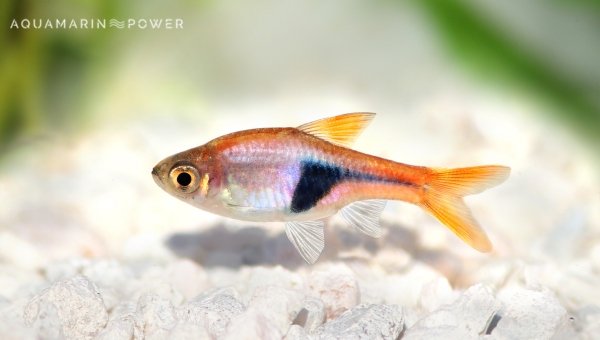
Filtration
The Harlequin Rasbora requires a filter that provides a moderate water flow. A canister or hang-on-back (HOB) filter will work fine. The filter should be cleaned every month. The filter must be changed every six months.
Aquarium Decor and Plants
The Harlequin Rasbora does not require any unique aquarium decor. They prefer a planted tank with plenty of hiding places. Rocks, driftwood, and live plants can create hiding places. The plants can be either natural or artificial. If artificial plants are used, they should be made of soft plastic to prevent the fish from being injured.
Substrate and Gravel
The Harlequin Rasbora does not require any particular substrate or gravel. Standard aquarium gravel will be fine. The substrate should be changed every six months. The substrate and gravel must be washed properly to remove all the dirt and impurities before adding them to the tank. The best substrate is fine-grained sand.
Ammonia and Nitrate level
The ammonia and nitrate levels in the tank must be kept at 0 ppm. Ammonia and nitrate are poisonous to fish and can kill them quickly. Even a small amount can prove to be fatal to the fish.
Tank Mates
The Harlequin Rasbora is a peaceful fish that can be kept with other small, peaceful fish. They are often seen in community tanks. Some good tank mates for the Harlequin Rasbora include:
- Tetras- Neon, Cardinal, Congo
- Gouramis- Pearl, Dwarf
- Barbs- Cherry, Tiger
- Rasboras- Scissortail
- Danios- Zebra, Leopard
- Loaches- Clown, YoYo
- Corydoras Catfish- Bronze, Pepper
Sexing the Harlequin Rasbora
The Harlequin Rasbora is challenging to have sex with. The only way to determine the sex of the fish is by looking at their genitalia. This can only be done when they are in breeding conditions. The males will have more pointed genitalia than the females.
Breeding
The Harlequin Rasbora is a difficult fish to breed. They are not known to spawn in captivity. Some people have successfully generated them using a spawning mop or net. The eggs will be deposited on the mop or net and hatch in a few days.
A spawning mop is a string or yarn tied to a stick. The mop can be made of different materials, such as wool, cotton, or nylon. This is used as a substrate for the eggs to be laid on.
A spawning net is a small net that is placed in the tank. Setting the trap is to catch the eggs as they are being laid. This method is not recommended, as removing the net without damaging the eggs can be difficult.
Eggs and Fry
The Harlequin Rasbora eggs are small and transparent. They will hatch in a few days. The fry is tiny and will need to be fed microscopic food such as baby brine shrimp, bloodworms, or infusoria. The fry will proliferate and reach its full size in a few months.
Growing Up
The Harlequin Rasbora is a hardy fish that does well in various water conditions. They can be kept in both cold water and tropical tanks. The fry can snowball and reach its full size in just a few months.
Parental Care
The Harlequin Rasbora is a peaceful fish that provides no parental care to the fry. The fry will have to fend for themselves once they are born. They should be kept in a separate tank to prevent them from being eaten by the parents or other fish.
How many can Harlequin Rasbora be kept in one tank?
The Harlequin Rasbora is a schooling fish and should be kept in groups of at least six. They can be kept in a ratio of 2:1 for males to females.
Diseases, Symptoms, Treatment, and Medications
The Harlequin Rasbora is a hardy fish and does not get sick often. However, they can be susceptible to the following diseases:
- Ich- This is a parasitic disease that causes small white spots to develop on the fish’s body. The fish will scratch itself against objects in the tank to remove the parasites. Ich can be treated with various medications, such as copper sulfate, formalin, or malachite green.
- Freshwater Flukes- These parasitic flatworms attach themselves to the fish’s body. The fish will scratch against the tank’s objects and have trouble breathing. Freshwater flukes can be treated with various medications such as Levamisole, Praziquantel, or Trichlorfon.
- Gill Flukes– These parasitic flatworms attach themselves to the fish’s gills. The fish will have trouble breathing and gasp for air at the water’s surface. Gill flukes can be treated with various medications such as Levamisole, Praziquantel, or Trichlorfon.
All the medications must be given with the advice of a vet or an expert. If your fish show any symptoms of illness, then they must be immediately looked at by an expert or a vet.
Advantages of having them in your tank
There are many advantages of having harlequin rasboras in your tank. Some of these advantages are:
- The Harlequin Rasbora is a peaceful fish that does not nip at the fins of other fish.
- They are hardy fish and do well in various water conditions.
- The fry can snowball and reach its full size in just a few months.
- The Harlequin Rasbora is a schooling fish and should be kept in groups of at least six.
Disadvantages of having them in your tank
Even though there are many advantages to having harlequin rasboras in your tank, there are some disadvantages too. Some of these advantages are:
- The Harlequin Rasbora is a difficult fish to breed.
- They are not known to spawn in captivity.
- It is hard to tell the difference between males and females
- They require a lot of hiding space.
Conclusion
The Harlequin Rasbora is a peaceful fish that is perfect for beginners. They are hardy and can be kept in various water conditions. The fry can proliferate and reach its full size in just a few months.
However, they are challenging to breed, and it is hard to tell the difference between males and females. They also require a lot of hiding space. The Harlequin Rasbora is a great fish for beginners and experienced aquarists.
We hope this article helped you with the information you needed about harlequin rasboras. We hope you do your research and add them to your tank. They will become amazing pets and bring a new spark to your tank!


